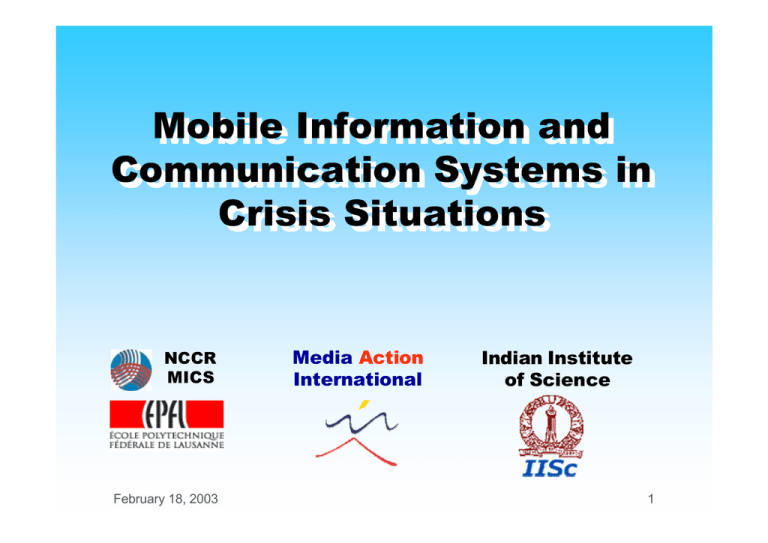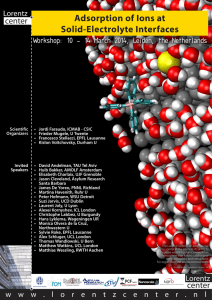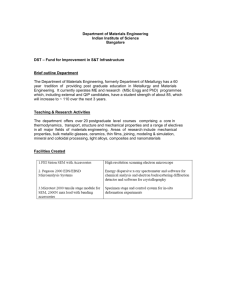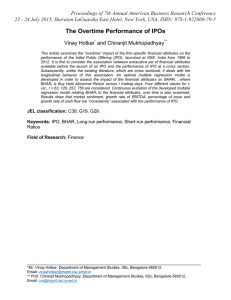Mobile Information and Communication Systems in Crisis Situations Media
advertisement

Mobile Mobile Information Information and and Communication Communication Systems Systems in in Crisis Crisis Situations Situations NCCR MICS February 18, 2003 Media Action International Indian Institute of Science 1 Contact Information EPFL (MICS) z Jacques Panchard: jacques.panchard@epfl.ch z http://www.terminodes.org Media Action International z Edouard Markiewicz: eddymark@mediaaction.org z http://www.mediaaction.org IISc z HS Jamadagni: hsjam@cedt.iisc.ernet.in z http://www.iisc.ernet.in February 18, 2003 2 Goal of the project Assess the communication needs that arise in crisis situations, and find out how to meet them. z Develop a theoretical framework z Identify the needs of the affected populations z Technical specification of mobile communication systems suited to fulfil the identified needs z Definition of deployment strategies February 18, 2003 3 Information is a First Necessity Good z Security, health, sanitation can be sought only with proper information. z Most victims of war and other crises have no access to independent, reliable information at a time when they need it most. z Information can be a question of life and death (e.g. AIDS in Africa). z Other kind of information: Sensor networks monitoring critical systems can prevent or mitigate catastrophes. February 18, 2003 4 Mobile Communication Systems Communication systems are necessary to convey information on a large scale. Mobile (Wireless) Communication Systems don’t need the same infrastructure as fixed ones to be deployed. Thus, they are : z Cheaper to put in place z Faster to deploy z More flexible to use February 18, 2003 5 EPFL and MICS z Mobile Information and Communication Systems (alias terminode) z One of the 14 NCCRs z MICS focuses on self-organized, ad hoc, infrastructure-less networks February 18, 2003 6 How do terminodes work? • Terminal and relay merge : Terminode • No more fixed infrastructure, self-organisation mandatory February 18, 2003 7 Interconnectivity Base Station PSTN Internet, … February 18, 2003 8 MICS Facts and Figures z Started November 2001 z 10 years research program z Budget : 8 million Swiss Francs per year z 30 faculty members and 80 PhD students z Director: Prof. M. Vetterli (EPFL) z Deputy Director: Prof. Th. Gross (EPFL) February 18, 2003 9 Media Action International (MAI) z http://www.mediaaction.org z Media Action International was founded in 1998 by professional journalists. z Media Action International bridges the gap between journalism and humanitarian, post-conflict and development activities. z Develop strategies to make the best use of the mass media. z Fight against illiteracy, poverty and disease. February 18, 2003 10 Indian Institute of Science zCentre for Electronics Design and Technology (CEDT) zCEDT was established at the Indian Institute of Science in 1974. zAreas of work in CEDT are Communication Networking, Electronics Packaging, Industrial Design, Instrumentation etc. February 18, 2003 11 Why do the EPFL, IISc and MAI team up on that project? z MAI focuses on content. z IISc and the EPFL focus on technology. z Pluri-disciplinary project aiming at empowering people in crisis situations by bringing them relevant content by an efficient use of technology. z Possibility to bridge a gap between the technical world and social and political sciences February 18, 2003 12 Project Consortium February 18, 2003 13 Project Deliverables 1. Compilation and analysis of resources and existing studies addressing the subject 2. Definition of a framework for the term “crisis situation” 3. Identification of information needs and information-sharing practices in different communities 4. Analysis of the field data and translation into a theoretical framework 5. Recommended action for the future February 18, 2003 14 D1 : Compilation and Analysis 1. Existing studies on the subject 2. Current regulatory process 3. Identification of the current key players in the relief operations, aid-to-development and humanitarian fields 4. Interview of those players 5. Compilation of success stories February 18, 2003 15 D2 : Definition Phase z Build up a model for crises z Identify phases in crises z Propose indicators to identify and assess the gravity of crises February 18, 2003 16 D3 : Field Study Two major themes: 1. What is the most important information to be conveyed in the considered situations. 2. What communication-path information follows to reach its target. z Iterative process with loop-back. February 18, 2003 17 D4 : Theoretical Framework z Technical specification of mobile and communication systems suited to fulfill the needs identified in D3. z Definition of a communication-sharing strategy February 18, 2003 18 D5: Recommended Action z Review and distribution of the document z Feedback from the partners of the consortium z Further action for the future: Realisation of a concrete project February 18, 2003 19 Bibliography zhttp://www.terminodes.org zhttp://www.mediaaction.org zhttp://www.iisc.ernet.in zLoretta Hieber, Lifeline Media: Reaching populations in crisis, Media Action International, 2001 zJacques Panchard, Jean-Pierre Hubaux, Mobile Information and Communication Systems in Crisis Situations, December 2002 February 18, 2003 20 Conclusion Goals z Prove that mobile communication systems are ideally suited to tackle humanitarian crises at their root. z Find technical requirements for optimal use of those systems. Emphasize the MICS solution z Draw strategies of deployment and isolate testcases for subsequent applications in the field. 1st Milestone: 31st December 2003 February 18, 2003 21





